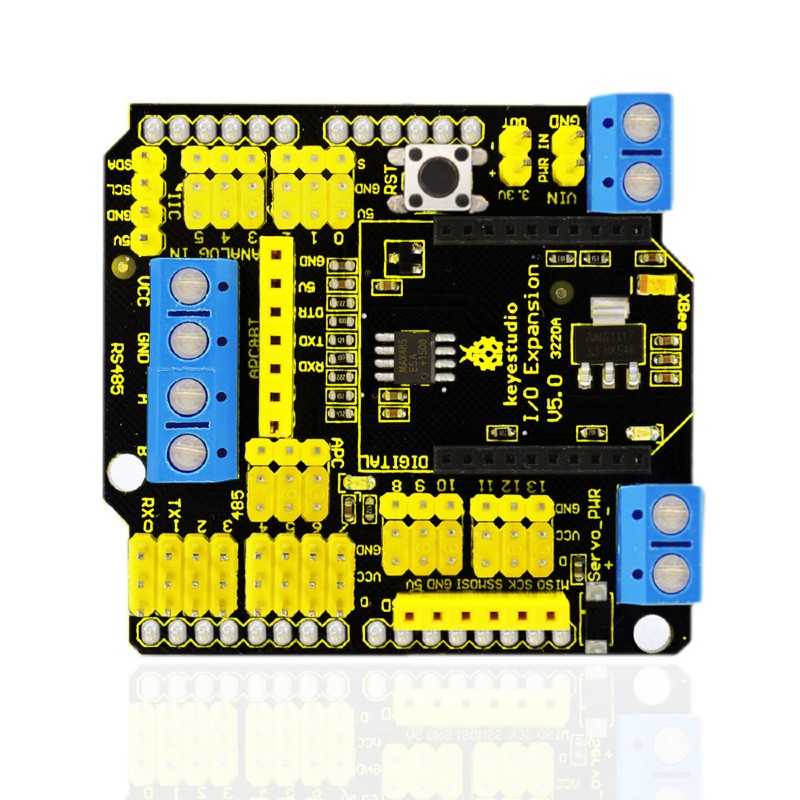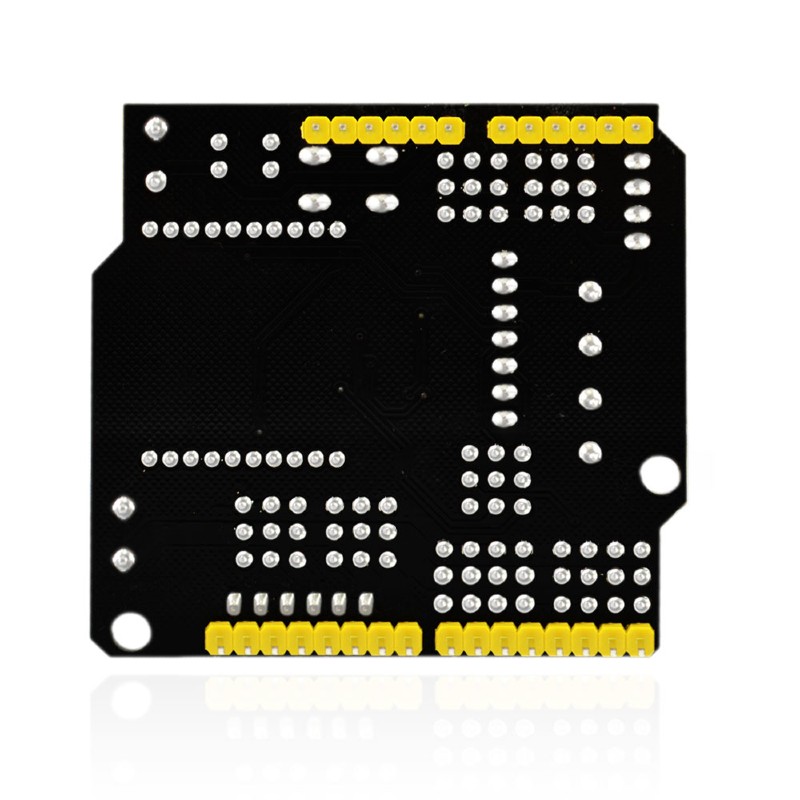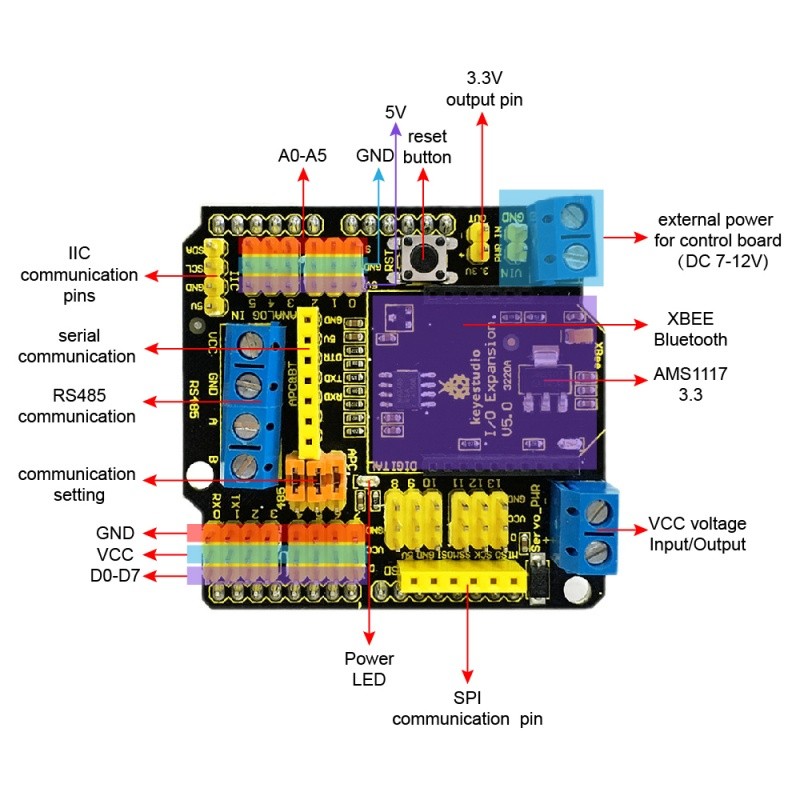Generic3

Specifications
- 400 tie points total: 300 tie-point IC-circuit area plus two 50 tie-point distribution strips providing 4 power rails.
- White ABS plastic body with black printed legend.
- Color legend on distribution strips.
- Size: 3.3 x 2.1 x 0.3in (84 x 54.3 x 8.5mm).
- Peelable adhesive tape backing provided for attaching to a surface.
What's in the box?
1 x 400 Point Breadboard
Resources
Features
- 2 wheels + motors mobile robot chasis
- Comes with all accessories to make a mobile robot
- Include 4xAA batteries holder
- Chassis size: ~215mm x ~150mm
- Wheel Diameter: 67mm
- Castor Height: 34mm
Motor parameters
- Comes presoldered with Red and Black wire, length ~ 15cm
- Bidirectional
- Gear Ratio = 48:1
- Speed with 66mm diameter wheel = 0.65 m/s at 7.2VDC
- Recommended operating voltage: 5 - 10VDC
- Noise level < 65dB
Current Consumption
- 100mA each motor at 3V
- 100mA each motor at 5V
- 120mA each motor at 6V
What's in the box?
2 x DC gear motor(TT motor) + Mini Wheel
1 x Castor wheel
1 x 4 X AA battery holder
1 x Rocker switch
2 x Black slotted disc
1 x Mounting screws and accessories
Specifications
| Colour | Size | Wavelength(nm) | Voltage(V) | MCD | Lens colour |
| Red | 5mm | 620-630 | 1.8-2.3 | 800-1000 | Red diffused |
| Yellow | 5mm | 580-590 | 1.8-2.3 | 800-1000 | Yellow diffused |
| Green | 5mm | 520-530 | 2.8-3.6 | 800-1000 | Green diffused |
| White | 5mm | 6000-6500k | 2.8-3.6 | 14000-16000 | Clear |
| Blue | 5mm | 460-470 | 2.8-3.6 | 800-1000 | Blue diffused |
What's in the box?
10 x coloured LEDs
- Red x 2 units
- Yellow x 2 units
- Green x 2 units
- White x 2 units
- Blue x 2 units
Resources
Python library
Introduction
You are purchasing a fantastic set of components to get you started! You can
measure light, time, magnetic fields, temperature, humidity...you can measure sound and create sound, you can measure tilt and user input! All of these components are presented on easy to access boards and allow you to connect them rapidly to the Arduino or Raspberry Pi, RP2040 Pico, ESP board.
Specifications
Product Dimensions: 10.63 x 7.09 x 1.73 inches
Item Weight: 14.1 ounces
Number of modules: 37
What's in the box?
1 x XY JoyStick
1 x Relay
1 x Big Sound
1 x Small Microphone
1 x Tracking
1 x Avoid
1 x Flame
1 x Linear Hall
1 x Touch
1 x Digital Temperature
1 x Buzzer
1 x Passive Buzzer
1 x RGB LED
1 x SMD RGB
1 x 2-Color LED
1 x 2-Color
1 x Reed Switch
1 x Mini Reed
1 x Heartbeat
1 x 7 Color Flash
1 x Laser
1 x Button
1 x Shock
1 x Rotary Encoders
2 x Magic Cup
1 x Tilt Switch
1 x Ball Switch
1 x Photo resistor
1 x Temp and Humidity
1 x Analog Hall
1 x Hall Magnetic
1 x TEMP
1 x Analog Temp
1 x IR Emission
1 x IR Receiver
1 x Tap module
1 x Light Blocking
Resources
We found a nice tutorial that covers most of the sensors here
We found this article explaining what the sensors are used for: http://www.instructables.com/id/Arduino-37-in-1-Sensors-Kit-Explained/?ALLSTEPS
Specifications
- Double H bridge drive
- Chip: L298N (ST NEW)
- Logical voltage: 5V
- Drive voltage: 5V-12V
- Logical current: 0mA-36mA
- Drive current: 2A (MAX single bridge)
- Storage temperature: -20 to 135
- Max power: 25W
- Weight: 30g
- Size: 43 x 43 x 27mm
Note
- This module has a built-in 5v power supply, when the driving voltage is 7v-12v, this supply is suitable as a power supply.
- DO NOT connect input voltage to 5v on controller interface.
- When ENA is enabled IN1 IN2 control OUT1 OUT2
- When ENB is enabled IN3 IN4 control OUT3 OUT4
What's in the box?
1 x L298N Module
Resources
- Robotic control with python
- L298 Datasheet
- Check out tutorial from instructables
This Plusivo Potentiometer Assortment Kit includes:
- 1Kohm -100Kohm Multiturn Trimmer
- 1Kohm -1Mohm Single Linear - High Precision Variable Resistor with Knobs.
- Aside from the trimmers, resistors, and knobs inside the box, you will find a mini screwdriver as a bonus.
Features
- The potentiometer kit contains Multiturn Trimmers, Linear-High Precision Variable Resistor with Knobs.
- Contains nuts and washers
- Free Mini Screwdriver
- 10 Type of Single Linear-High Precision Variable Resistor.
- 5 types of multiturn trimmer.
What's in the box?
1 x Single Linear-High Precision Variable Resistor 1 kΩ
1 x Single Linear-High Precision Variable Resistor 2 kΩ
1 x Single Linear-High Precision Variable Resistor 5 kΩ
1 x Single Linear-High Precision Variable Resistor 10 kΩ
1 x Single Linear-High Precision Variable Resistor 20 kΩ
1 x Single Linear-High Precision Variable Resistor 50 kΩ
1 x Single Linear-High Precision Variable Resistor 100 kΩ
1 x Single Linear-High Precision Variable Resistor 250 kΩ
1 x Single Linear-High Precision Variable Resistor 500 kΩ
1 x Single Linear-High Precision Variable Resistor 1 MΩ
1 x multiturn trimmer 1 kΩ
1 x multiturn trimmer 5 kΩ
1 x multiturn trimmer 10 kΩ
1 x multiturn trimmer 50 kΩ
1 x multiturn trimmer 100 kΩ
1 x multiturn trimmer 100 kΩ
1 x mini screw driver
Resources
Python Library
Definition, Types, And Working Principle
You can change the communication way via the jumper cap on the shield. If all the three jumpers are connected to APC, the shield will realize the XBEE Bluetooth communication. If all jumpers are connected to 485, realize the RS485 communication function.
Onboard also comes with a reset button, a D13 indicator, and some common communication pins of 2.54mm pin pitch, such as serial port, IIC, and SPI communication pins.
Besides, it also has two 2pin terminal blocks. One is VIN GND terminal block, used to supply the external power for the UNO R3 control board, with an input voltage of DC 7-12V. The other is the Servo_PWR terminal block, used for VCC voltage input/output. If not connecting the external voltage, supply 5V for the shield; if connecting the external voltage, VCC voltage is actually the external input voltage.


- Compatible with Arduino UNO R3.
- Comes with 14 digital input/output pins.
- Comes with 6 analog IO pins
- Onboard comes with a digital port power terminal block
- Comes with an external power input terminal block and a input contact pin ( power on the control board with DC 7-12V)
- Comes with an RS485 interface.
- Comes with a reset button
- Comes with a D13 indicator
- Comes with a XBEE Bluetooth interface
- Can connect three jumper caps (APC and 485) to switch the XBEE Bluetooth communication or RS485 communication.
- Comes with I2C, serial port and SPI communication pins
- Onboard comes with a DC 3.3V output pin
- Dimensions: 58.5mm x 57.5mm x 20mm
- Weight: 26.2g
Pinout diagram

1 x XBEE Shield with RS485 for Arduino UNO
Resources
Product wiki page
Note: This kit comes with 4x AA batteries.
Note: Download the softcopy instruction manual (English) here.
Images are for references onlyDescription:
The DIY (Do It Yourself) Kit for Children Age 4 to 12 Years Old
Have you seen a tennis ball launcher? No? Well, in this kit, you will learn how to build your very own ball shooter! But instead of using a tennis ball, you will be shooting with a foam ball with extreme speed! While building the launcher, you will also learn how to connect a DC motor with hook up with wheels which creates friction on the foam to launch it forward.
Features:
- Do It Yourself Foam Ball Launcher
- Suitable for age 6 years old and above
- Come with everything needed to assemble the launcher project
- AA batteries included
- Learn about DC motor and the concept of friction on different objects and surfaces
- Be able to launch paper balls and various materials (Not included in the kit)
Packing List:
- Wooden parts for the launcher structure
- Some double-sided tape
- Some screws
- 2 x orange stopper
- 1 x AA battery holder
- 1 x DC motor
- 1 x Metal rod
- 2 x Wheel
- 1 x Big metal bracket
- 2 x Small metal bracket
- 5 x Circular foam
- 1 x Screwdriver
Resources:
Creality Ender-3 hotend specifications
- The aluminium heating block measures 20 x 20 x 10 mm
- Heat sink with dimensions: 20 x 27 x 7 mm
- The head has a lead-out:
- Thermistor
- Heater tube
- Teflon tube for filament supply
- Hotend suitable for printing with 1.75mm diameter filament
- Nozzle: 0.4 mm
- Applicable models: Ender-3, Ender-3s, Ender-3 Pro, Ender-3 V2
What's in the box?
1 x hotend kit
The chip's fairly small so it comes on a breakout board with ferrites to keep the AVDD and AGND quiet. Interfacing is done via I2C. The address can be changed to one of four options (see the datasheet table 5) so you can have up to 4 ADS1115's connected on a single 2-wire I2C bus for 16 single-ended inputs. For example, your Raspberry Pi can read voltage from load cell:

To get you started, here is example code for both the Raspberry Pi (in Adafruit Pi Python library), Arduino (in ADS1X15 Arduino library repository) and CircuitPython. Simply connect GND to ground, VDD to your logic power supply, and SCL/SDA to your microcontroller's I2C port and run the example code to start reading data.
- Breakout board with standard header spacing (2.54mm)
- Uses ADS1115 ADC converter IC
- Up to
16-bitresolution, we can only get 12-bit resolution. - Wide Operating Voltage Range: 2.0V to 5.5V
- Compatible with both 5V system like Arduino
- And 3.3V system like Raspberry Pi
- Low Current Consumption:
- Continuous Mode: Only 150µA
- Single-Shot Mode: Auto Shut-Down
- Programmable Data Rate: 8SPS to 860SPS
- Internal Low-Drift Voltage Reference
- Internal Oscillator
- Internal PGA
- I2C interface, only 4 wires needed to Raspberry Pi or Arduino
- Pin Selectable I2C Addresses
- Four Single-Ended or Two Differential Inputs
- Programmable Comparator
- This board/chip uses I2C 7-bit addresses between 0x48-0x4B, selectable with jumpers
What's in the box?
1 x 10-ways header pin
- ADS1115 4-Channel ADC Uses I2C with Raspberry Pi, by Lewis Loflin
- Raspberry Pi Analog to Digital Converter, tutorial by Adafruit
- ADS1115 Datasheet
- ADS1115 Python Library by Adafruit
- ADS1115 library for Arduino by Adafruit
In case your thermal pads for the Raspberry Pi mainboard are getting bad or old, you can use these pads to replace them.

It comes in two pieces, one dedicated for the CPU (in square shape) while another is meant for the RAM IC (in rectangle shape). Both sides of each thermal pad are adhesive and of course, come with a protective sheet that you need to peel off before sticking it to the IC or heatsink surface.

These thermal pads will ensure efficient heat dissipation to the heatsink from the CPU and RAM IC on the Single-board computer. Make sure the Raspberry Pi is in cool condition in any situation :)
- Simple and effective thermal pads
- Comes in two pieces
- One for CPU and another for RAM
- Can be used as a thermal paste for the heatsink as both sides of the pads are adhesive surface
- Perfect fit for Raspberry Pi 3, 4 and 5 mainboards.
Dimensions
- Square: 15mm x 15mm x 2mm
- Rectangle: 10mm x 15mm x 2mm
What's in the box?
1 x Square shape thermal pad with adhesive surface
1 x Rectangle shape thermal pad with adhesive surface
The Battery Holder is suitable for 9 Volt Batteries. The pro of having this battery holder is that it allows you to switch off power for Arduino without having to remove the DC barrel plug each time. This Battery Holder has an easy-remove sliding cover. The removable battery cover is at the opposite side of the ON/OFF switch.
Specifications
- For 9 DCV Battery
- Power Connector: 2.1mm DC Plug Suitable for Arduino
- Colour: Black
- Comes with cover and slide switch to ON (Close) and OFF (Open) battery connection to the load
What's in the box?
1 x DC9V Battery Holder with Switch + Cover + Power Jack














.JPG)
.JPG)